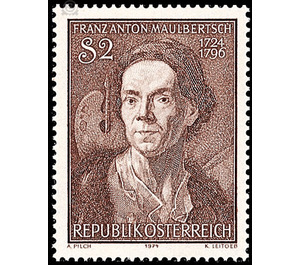250th birthday - Austria / II. Republic of Austria 1974 - 2 Shilling
Theme: Animals
| Country | Austria / II. Republic of Austria |
| Issue Date | 1974 |
| Face Value | 2.00 |
| Color | multi-colored red |
| Printing Type | Typography |
| Stamp Type | Commemorative |
| Item Type | Stamp |
| Chronological Issue Number | 797 |
| Chronological Chapter | OOS-OE2 |
| SID | 67599 |
| In 62 Wishlists | |
Franz Anton Maulbertsch was born in 1724 in Langenargen on Lake Constance. Maulbertsch stands in a tradition in which the ceiling painting of the southern German-Austrian area reached a climax. His contribution to the Austrian painting of the late Baroque period not only meant a climax, but also a turning point. It is a highlight in terms of the quality of the painting technique. It means turning, because he tried with this art to find the connection to the tendencies of the new era of classicism. Maulbertsch's penchant for religious topics, his deeply felt talk, the lack of serene and above all erotic themes, make him an artist who reluctantly relinquished his relationship to the high Baroque tradition. In moments of his work, for example in the fresco by Halbthurn, he is very close to the rococo. He loved the spread of painting to architectural elements, forced the total work of art almost entirely into painting, as in the Piaristenkirche in Vienna. On the other hand, Maulbertsch did not have much of the lightness of the style of the time. Apparently he felt more comfortable with the depictions of saintly stories and holy martyrs. But he also showed again quality: He wanted to follow his artistic temperament and not the zeitgeist. The brand image shows the self-portrait by Franz Anton Maulbertsch from the Austrian Gallery.


